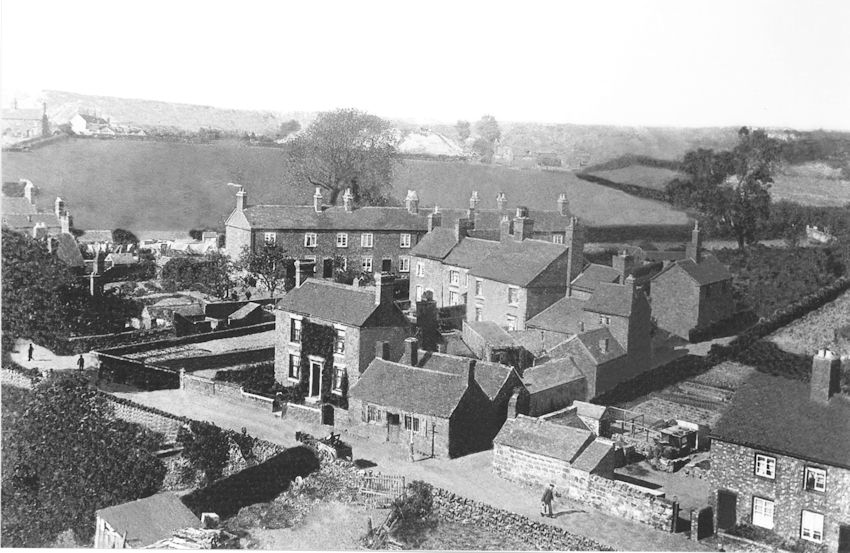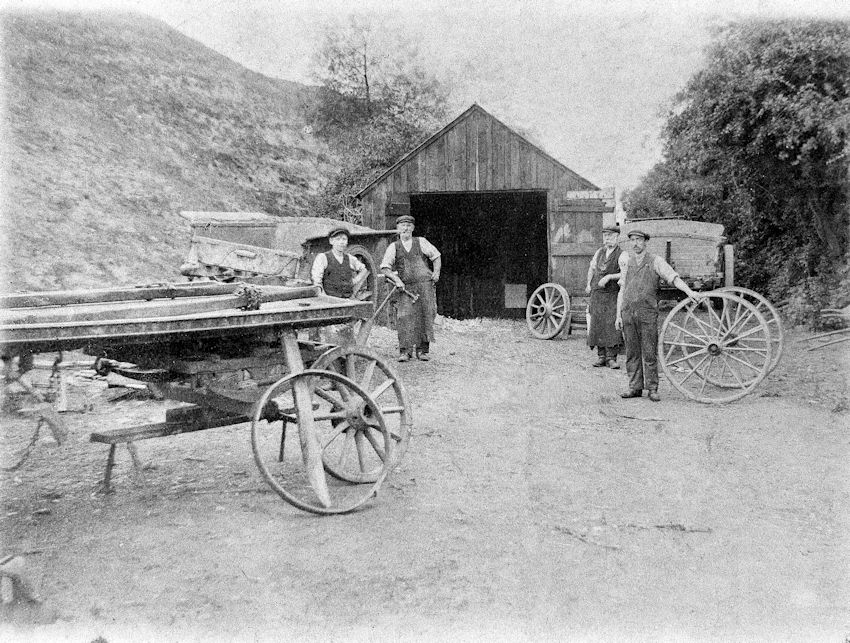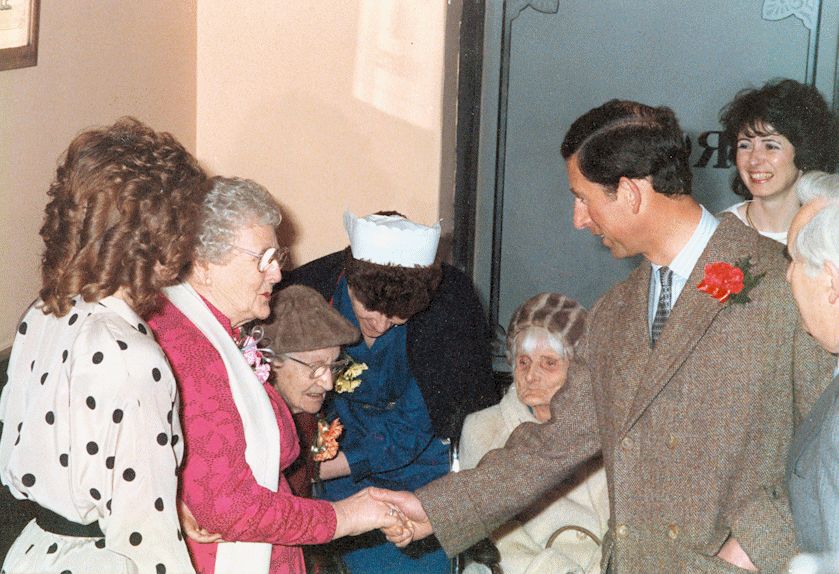Elsie Day
My name is Ros Collin, the present owner of Hazeldene House in Southall Road, Dawley (now a guest house) The warmth this house emitted was enough to make me buy it 6 years ago and start a new life.

Elsie Kate Merrington
I can look out of my lounge window at the front of the house and through the broken green gate opposite I imagine Elsie Day in her tweeds and twin-set (minus the pearls as they would have been too flamboyant) in her wellington boots tending to the vegetable garden. This was back in the 1950's when Southall was the main A442 road to the south and not as now' a very busy fast 'B'road. My imagination can go back further and see the road as a dirt track with the occasional horse and cart gently passing by and the Merrington family in their Victorian regalia. I am told about this family's generosity, especially during the closure of Stirchley forge and Furnaces around 1904, Elsie's Mother would cook a bucket of stew for the poor once a week and the other days she would feed them bread and jam.
I heard snippets of information from various neighbours about the history of this Georgian house and then became interested in the history of Mrs. Elsie Day who lived in this house for 87 years. She was born Elsie Kate Merrington in 1885 and died in 1996; the oldest woman at that time in Shropshire aged 110 and three-quarters. The Merrington family was quite a well to do family, and very highly thought of in the area and even employed a maid.
Mrs. Day sounds a remarkable character, tenacious and a very strict disciplinarian, but a fair, dominant, schoolmarm with a philanthropic side. Boys with reading difficulties were sent over to help with the vegetable garden but apparently they did not do any gardening, maybe because Mrs. Day liked to be in charge and do everything herself! With her detail to phonetics and the individual attention, she, and her sister Belle, taught these boys to read and write where the school had failed, one boy in particular, became a jockey and every year on Mother’s Day he returned to see the family. He knew if he had not learnt to read and write he would not have been successful in his chosen career.
In 1913 Elsie Merrington was appointed Headmistress of Stirchley School, remaining in this post until 1927. It must have been a very proud day for Elsie when she attended the opening ceremony in her 106th year, when her school was re-erected at Blists Hill Museum on 25th June 1992. It was a council school, not a church school, with 80-90 pupils. It had a high attendance of farmer’s children from the rural community of Stirchley and the urban district of Dawley. The pupils usually found employment on the land and did not have to move away from the district to find work.
She began her own education at the age of 4 at the Langley School, Dawley and never really left; at 15 she became a pupil teacher, then a trainee teacher. The poorer pupils could obtain a Labour Certificate, if they had good attendance the pupils could leave at the age of eleven, and the families would be glad of their earnings. The girls went to work at the pit bank or domestic service. Wages were very poor in Dawley and the girls discovered they could earn better wages in Lancashire in the cotton factories. They often met their husbands there and never returned. Many of the families plus the children went hop and fruit picking in Hereford, and treated the work as a holiday.
From the marriage register for Dawley Parish Church (Holy Trinity) Elsie married Walter Edward Day on 19th April 1927. Walter had served in the 1914-18 war as a soldier and became a milk retailer living in Finger Road and his Father was a retired grocer from the Isle of Wight. Elsie was 41 years old. Walter was age 33. Unfortunately Walter Day died of cancer after only three years of marriage. When she was married she moved next door to a property owned by the family and after his death she returned to Hazeldene to live with her Mother, Brother and Sister. In those days the education system did not allow female teachers to be married, so she resumed her career after sadly becoming a widow.

Elsie & Walter
Belle Merrington, Elsie's sister, was the headmistress of Mr. Parry's Malinslee Institute School for 36 years and was the more outgoing of the sister. She sounds ahead of her time really as she was riding motorbikes, driving cars and smoking. ! She was very sporty and played golf regularly at the Wrekin Golf Club, Wellington. There was also brother, Charles who was an academic, and he also became a teacher and was the choirmaster at Malinslee Church. The other brother, Edwin, was an engineer at Sentinel Wagon Works, Shrewsbury, and became the Works Manager. He lived with his wife Edith Clara Evason, and son John in Sundorne Road, Shrewsbury. He also played football for Shifnal Town before joining Shrewsbury Town, and was known as “Teddy” but his full name was Edwin Guildford Merrington.
Mrs. Day's great grandfather founded the chain making business and blacksmiths shop around 1820. He served his apprenticeship with the Quaker chain maker Benjamin Edge at Coalport. When Edge’s family moved to Shifnal, Charles set up his own chain making at Dawley. Most of the chain-making was done for the collieries belonging to Fosters of Apley. Henry Henshaw Merrington became a member of the Worshipful Farriers in 1897.
In the grounds of the enclosed photograph were six workshops which were run by John and Henry Merrington, who were first class craftsmen, and part of their work was forging of the link chains used for the surrounding pits. The Merrington family ran the business for over one hundred years and the fourth generation of Merringtons still lived at Hazeldene House until Mrs. Day left it to go into a home. Therefore the house was occupied by the same family for over 150 years.

Hazeldene House, with Ivy Growing on the Front
Apart from the chain-making all horses in the area were shod there and as many as forty horses would be left at the blacksmiths before breakfast to have frost nails put in their shoes in the winter (much bleaker and severe winters were experienced than current times.)
Opposite the smithy were two pit mounds between which was the Wheelwrights shops, which made wheels for all types of vehicles (see photograph).

Merrington's Blacksmiths & Pit Chain Makers
I find it fascinating listening to a tape that was recorded by Shropshire Radio on Mrs. Day's 100th birthday. Her voice is unfaltering and crystal clear reminiscing about the great event in Dawley, the celebration of Queen Victoria's Diamond Jubilee. She also remembered the ending of the Boer War in 1901 and that on Monday 25th May 1900 a holiday was given to everyone to celebrate the relief of the Mafeking. She lived through two world wars and remembered the depression in the Dawley area, vividly; caused by the closure of Stirchley Furnaces. She could recall with clarity the days when children had to take their pence to school each week to enable them to enjoy the privilege of an education. In 1880 education was compulsory between the ages of 5 to 10 (poor families were exempted from paying). It was in 1918 that the school leaving age was raised to 14; and the Butler Education Act in 1944 raised the age to 15 with the 11 plus introduced to enter higher education.
There are lots of stories and anecdotes about the formidable Mrs. Day. They were the first family to taste tomatoes, as they were sent by Walters Day's parents as a present, from the Isle of Wight, and they really did not know whether to put salt or sugar on them. The Merringtons were also the first family in the area to have electricity even despite their frugality. Elsie Merrington when she became a school teacher was expected to teach swimming, but despite being scared of water she lay on a beam in the gym and actually taught herself to the actions of swimming and later overcame her fear. Another story related to me about the Merringtons was that when they needed to consult their solicitor from Wellington, he was invited to the house and told “come at 12 o’ clock because my brother likes his sherry then”. After the brother had died, the story became “come at 12 o’clock as my sister likes her sherry then”. Then when she died it was “come at 12 o’clock as I know you like your sherry then. I think Elsie liked a drop of sherry!
Another story to come out of the home was that the two ladies who were introduced to Prince Charles had a healthy rivalry between themselves, and Elsie overheard the other lady telling Prince Charles that she was the eldest in the home but Elsie interrupted the conversation saying “She is telling you an untruth your Highness. There are two of us over one hundred years old, and I am the elder!!” Precise to the end.
My favourite story is when on her 100th birthday she was introduced to Prince Charles and her conversation went "I am very pleased to meet you Sir. I do hope you are keeping well and, oh by the way how's your Mother???".

Mrs Day standing next to the lady being introduced to Prince Charles.
This tiny diminutive lady was still bustling around, looking after her younger sister, who had heart trouble, when she was in her nineties. She broke her hip at 102, recovered well, and spent the rest of her life in Lincoln Grange Residential Home, Madeley, where according to her nephew, John Merrington; she treated it as a luxury hotel, and the staff as servants.
What a remarkable lady, not just because of her longevity, but also because of the clarity of her memories of her 110 years and her ability to express herself so clearly when recalling those moments.
By Ros Collin